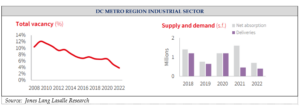When we wrote our year-end update just three months ago, the war in Ukraine wasn’t on our radar screen. Now the implications of this horrible conflict on our economy, and indeed the world order, are confronting us on many different levels. As an investor, one lesson to learn or perhaps relearn, is how important it is to be invested in a diversified way because impactful events happen at times and in ways that will defy prediction for many of us, even those that may be wary of unforeseen risk.
While the current wall of worry is high, economic indicators in the US and the Washington-metro area remain strong and stable, with the region projected to slightly outperform the US in job and population growth over the next few years as reflected in the chart below:

While inflation is certainly a concern, job growth continues to be robust and the property markets in our region look particularly strong. Apartment absorption topped twenty thousand units over the last year, almost triple the historical average, and rents followed suit, increasing over 10% for the same period. Demand for industrial space continues to exceed supply, putting significant upward pressure on rents, and even office workers are slowly coming back to the office. In the first quarter, the office market showed positive net absorption for the first time in three years. These data points are all signs of a continued real estate fundamentals boom.
There are still some headwinds out there, to be sure. The primary concern is inflation and the attendant risk of rising interest rates. With interest rates rising and cap rates falling, particularly in apartments and industrial, positive leverage is hard to achieve for new acquisitions. One acquisition justification we are hearing is that positive leverage will be achieved in two to three years after acquisition as a result of rising rental rates on apartments and contractual rental increases on industrial. This feels like a workaround for a transaction whose underlying fundamentals are priced (or maybe even overpriced) to perfection and thus not leaving much room for error. Part of the explanation for the surge in apartment demand relates to recovery from the pandemic, and one must question whether the trend over the last twelve months is sustainable over the longer term. At the same time, accelerating inflation has caused construction costs to increase by double digit percentages over the past year. This rapid increase has made it more difficult to underwrite new development projects without assuming prolonged rental rate growth and a low cap rate environment. While we like the apartment market, real estate values are cyclical, and the light may be turning from green to yellow. Industrial demand looks to be more durable as the e-commerce economy grows and other demand drivers persist, which will likely sustain the leasing strength experienced over the last several years.

We are transitioning away from the pandemic, from 20 years of low interest rates, and from a period of post-Cold War peace and stability to a period where risk in many arenas is hard to underwrite. As real estate investors, we know that trees don’t grow to the sky, interest rates don’t always fall, it’s never easy to see around the corner and that a diversified portfolio of good real estate provides the best protection against an uncertain future.
